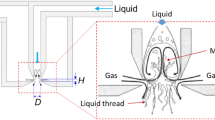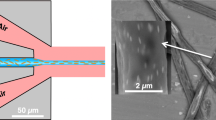Abstract
Continuous, small-diameter polymer fibers may be fabricated by a method that involves injecting a solvated polymer into a highly viscous moving medium through a microaperture. The extruded fiber moves in a predictable spiral path and is collected around a spinning mandrel that also serves to pull the extruded fiber away from the aperture. In this study, fibers as small as 400 nm diameter were observed, but there was no indication that the experiments reported here have achieved the smallest structures possible by this technique. Video microscopy experiments revealed significant fiber diameter reduction in close proximity to the point of precursor injection via hydrodynamic focusing. This occurred due to flow mismatch between the precursor and surrounding media. This effect may be the dominant draw-down mechanism in a process that can produce truly continuous nanofiber. This method is capable of generating fibers from precursors with viscosities that would render them unspinnable by any other known method.
Similar content being viewed by others
References
Y. Xia, P. Yang, Y. Sun, Y. Wu, B. Mayers, B. Gates, Y. Yin, F. Kim, and H. Yan: One dimensional nanostructures: Synthesis, characterization and applications. Adv. Mater. 15, 353 (2003).
S. Megelski, J.S. Stephens, D.B. Chase, and J.F. Rabolt: Micro- and nano-structured surface morphology on electrospun polymer fibers. Macromolecules 35, 8456 (2002).
D. Li and Y. Xia: Direct fabrication of composite and ceramic hollow nanofibers by electrospinning. Nano Lett. document No. 10.1021/nl049590f.
C. Brinker and G. Scherer: Sol-Gel Science: The Physics and Chemistry of Sol-Gel Processing (Academic Press, San Diego, CA; London, 1990).
S.F. Fennessey and R.J. Farris: Fabrication of aligned and molecularly oriented electrospun polyacrylonitrile nanofibers and the mechanical behavior of their twisted yams. Polymer 45, 4217 (2004).
F. Ko, Y. Gogotsi, A. Ali, N. Naguib, H. Ye, G. Yang, C. Li, and P. Willis: Electrospinning of continuous carbon nanotube-filled nanofiber yarns. Adv. Mater. 15, 1161 (2003).
High-Speed Fiber Spinning: Science and Engineering Aspects, edited by A. Ziabicki and H. Kawai Krieger Publishing Co. (1991).
W.K. Son, J.H. Youk, T.S. Lee, and W.H. Park: The effects of solution properties and polyelectrolyte on electrospinning of ultrafine poly(ethylene oxide) fibers. Polymer 45, 2959 (2004).
Y. Dzenis: Spinning continuous fibers for nanotechnology. Science 304, 1917 (2004).
I.G. Loscertales, A. Barrero, M. Marquez, R. Spretz, R. Velarde-Ortiz, and G. Larsen: Electrically forced coaxial nanojets for one-step hollow nanofiber design. J. Am. Chem. Soc. 126, 5376 (2004).
D. Li, A. Babel, S.A. Jenekhe, Y. Xia, D. Li, A. Babel, S.A. Jenekhe, and Y. Xia: Nanofibers of conjugated polymers prepared by electrospinning with a two-capillary spinneret. Adv. Mater. 16, 2062 (2004).
M.M. Hohman, M. Shin, G. Rutledge, and M.P. Brenner: Electrospinning and electrically forced jets. I. Stability theory. Phys. Fluids 13, 2201 (2001).
A. Theron, E. Zussman, and A.L. Yarin: Electrostatic field-assisted alignment of electrospun nanofibres. Nanotechnology 12, 384 (2001).
D. Li, Y. Wang, and Y. Xia: Electrospinning nanofibers as uniaxially aligned arrays and layer-by-layer stacked films. Adv. Mater. 16, 361 (2004).
H. Varghese, S.S. Bhagawan, S.S. Rao, and S. Thomas: Morphology, mechanical and viscoelastic behavior of blends of nitrile rubber and ethylene-vinyl acetate copolymer. Eur. Polym. J. 31 (10), 957 (1995).
O. Evstatiev, M. Evstatiev, S. Fakirov, and K. Friedrich: Manufacturing and characterization of microfibrillar reinforced composites from liquid crystalline polymers and poly(phenylene ether). Plast., Rubbers Compos. 33 (8), 353 (2004).
J.Y. Kim, S.H. Kim, and T. Kikutani: Fiber property and structure development of polyester blend fibers reinforced with a thermotropic liquid-crystal polymer, J. Polym. Sci. Part B: Polym. Phys. 42, 395 (2004).
J.B. Faisant, A. Ait-Kadi, M. Bousmina, and L. Deschenes: Morphology, thermomechanical and barrier properties of polypropylene-ethylene vinyl alcohol blends. Polymer 39, 533 (1998).
C. Lacroix, M. Grmela, and P.J. Carreau: Morphological evolution of immiscible polymer blends in simple shear and elongational flows. J. Non-Newtonian Fluid Mech. 86, 37 (1999).
M. Gorantla, S.E. Boone, M. El-Ashry, and D. Young: Continuous polymer nanofibers by extrusion into a viscous medium: A modified wet spinning technique. Appl. Phys. Lett. 88 2006.
P. Doshi, I. Cohen, W.W. Zhang, M. Siegel, P. Howell, O.A. Basaran, and S.R. Nagel: Persistence of memory in drop breakup: The breakdown of universality. Science 302, 1185 (2003).
I.G. Loscertales, A. Barrero, I. Guerrero, R. Cortijo, M. Marquez, and A.M. Ganan-Calvo: Micro/nano encapsulation via electrified coaxial liquid jets. Science 295, 1695 (2002).
S.L. Anna, N. Bontoux, and H.A. Stone: Formation of dispersions using “flow focusing” in microchannels. Appl. Phys. Lett. 82, 364 (2003).
A. Ziabicki: Fundamentals of Fibre Formation: The Science of Fibre Spinning and Drawing (John Wiley & Sons, 1976).
A.S. Utada, E. Lorenceau, D.R. Link, P.D. Kaplan, H.A. Stone, and D.A. Weitz: Monodisperse double emulsions generated from a microcapillary device. Science 308, 537 (2005).
Author information
Authors and Affiliations
Corresponding author
Rights and permissions
About this article
Cite this article
Gorantla, M., Boone, S.E., Clark, C. et al. Extrusion of a solvated polymer into a moving viscous medium allows generation of continuous polymer nanofibers via hydrodynamic focusing. Journal of Materials Research 22, 989–993 (2007). https://doi.org/10.1557/jmr.2007.0115
Received:
Accepted:
Published:
Issue Date:
DOI: https://doi.org/10.1557/jmr.2007.0115




